Written by R. Ann Parris on The Prepper Journal.
Editors Note: Another article from R. Ann Parris to The Prepper Journal. As always, if you have information for Preppers that you would like to share then enter into the Prepper Writing Contest with a chance to win one of three Amazon Gift Cards with the top prize being a $300 card to purchase your own prepping supplies!
In some cases, modern information sharing and science leads us to throw away conventional wisdom’s – rightfully so. However, there are tidbits from history that still apply, particularly to preppers and modern homesteaders.
I’ve looked at historic trail foods, rations, and preservation methods before, from both the travel aspect and the ability to preserve harvests. This time, I want to look at the dogged insistence that soldiers required more variety to combat food fatigue starting in World War II and the items we as preppers regularly consider luxuries but that were must-have basics for both soldiers and the settlers walking beside wagons during western expansion.

Wagon Train Meals
First up, let’s poke at the typical meal schedules of the western-expansion pioneers. That’s a hot meal morning and evening (makes total sense – so does the fact that beans got served in the morning). Many backpackers follow the same trend, or only have one hot meal.
In between, pioneers had a midday meal.
They stopped in the heat of the day, and they ate. Usually it was leftovers from breakfast, or it might be just crackers, dried fruit, and jerky, but they ate. The civilians, the miners, the military, migrating natives, USGS survey teams … pretty well across the board, on the trail and once they settled in somewhere.


A lot of packers and military rations are set up for some snacking through the day, in lieu of or in addition to that midday meal, and some preppers plan for the same.
I bring it up, because there are also preppers who actively plan to only eat twice a day. Addressing the “two meals a day” idea really deserves a little more focus, but I wanted to slide it in here super quick. There’s plenty of research and history to consider, from pioneers and early soldiers to pre-petrol and early-tractor farmhands.
Luxury vs. Staple
From the days before western expansion when supplies were hauled across the entire continent after crossing oceans, through the War Between the States and the days of the “greatest generation”, there was a constant. It’s a constant we as preppers most usually stick in the “luxury” category and plan to do without.
That constant is a warm brown drink.
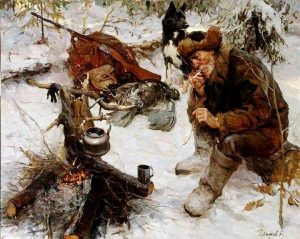
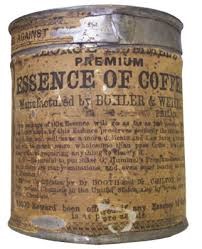

Now, society has changed. If you don’t drink soda, tea, coffee or anything but some juice you can produce, sure, ignore this section.
If you do, remember that it was worth risking life, limb, and imprisonment to trade for or steal coffee in numerous conflicts, before and after repeating firearms. It was one of the must-have supplies on wagon trains.
Hardship survivors and grrr-tough folks throughout history became so accustomed to tea and coffee, they’ve toasted, roasted, and brewed darn near anything to create replacements when they can’t get real. (Bonus Factoid: Some of those replacements lived on in products like the LDS’s Postum, but coffee and tea were on the Mormon Trek provision lists.)
Hard to Swallow
On the page http://www.kration.info/original-k-rations.html, the author states, “The ‘frilliness’ of the ration has been defended as follows: ‘[sic]While this ration has seemed unnecessarily complex to some, the variety contained in it is deliberate. No simple ration has yet been found which did not became tiresome within a few days that the test subjects did not eat sufficient to meet their nutritional requirements’.”

The author doesn’t credit that particular quote (that I found) but very similar text can be found in letters to and the minutes of quartermaster and ration-creation commissions during WWII and in post-war years.
There’s a big takeaway there.
In the days when you ate what was in front of you from childhood up, in a period when we ate relatively regionalized foods with fewer cultural foods increasing our variety, high-activity soldiers were failing to eat enough of the available foods to maintain health and condition.
Some added context? Those study soldiers were children and young adults during the Great Depression.
The quartermasters pushing for more variety were mostly adults during those eras of shortages and outright hunger. Some of them were young soldiers in the First World War.
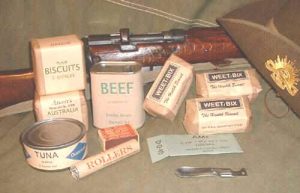
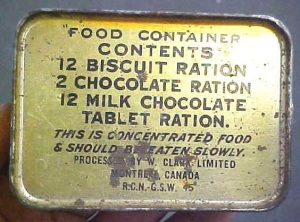
Variety wasn’t solely a U.S. focus. And, remember: Many nations didn’t experience the economic booms of the U.S. in the interim’s of war, or have the alleviation of the Depression that North America offered.
Those tough cookies are the ones who started waving flags about what is now defined as “food fatigue”.
Think that through for a minute.
They faced the same “bah, they’ll eat if they’re hungry” reactions we regularly see in the beans-and-rice and MRE prepper factions. But they managed to slap enough evidence in front of naysayers to expand and improve rations.

Lessons from Chocolate
Increasing the variety, ease, and satisfaction of military rations remains an issue, even in the MRE and UGR generations. It’s something other nations continue to address as well. However, we can learn a lot just from the battles quartermasters fought over rations during WWII – notably, the shape of cans (lost), better heating options (draw), and increasing unit-sized options (won).
For those curious, this page http://www.kration.info/partial-dinner-units.html lists ration items and menus for the partial-dinner “D” 10-in-1 units as they evolved, including the progression of K-rats to C-rats.
Ration candy has a slew of lessons to offer all on its own.
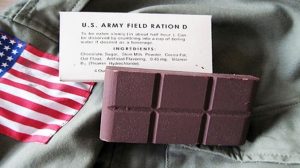
The original WWII chocolate came in bars so thick, they were difficult to eat, especially in cold conditions. The solution was multiple thinner bars. We can see that trend still in the “travel-soap” bars of the Italian rations and some other nations.
A requirement for small, incremental portions of other candies also goes all the way back to K-rats, 10-in-1’s, and C-rats – stipulating 5-8 individually wrapped pieces per serving. That prerequisite lives on in numerous international rations that provide handfuls of individually wrapped caramels, hard candies, and dextrose wafers, portion-able chocolate, and rolls of candies.
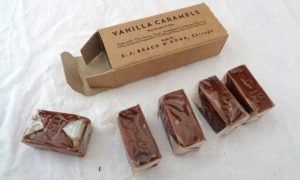
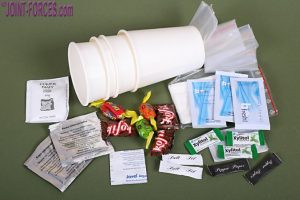
We also see the military’s continued focus on those points in the multiple small nougat, jelly, and energy bars some nations include, and the other small snacky bits common to modern military rations.
All of them help us evaluate our personal food storage and resupply plans.
How much is going to be difficult to get our teeth around and break off in cold weather or if we have a tender mouth? (Hello, emergency ration bars.)
Are there eat-as-is options, whether it’s prepackaged or the ability to make foods for later consumption?
Do we have options that let us eat little bits at a time, to account for quick breaks, busy hands, long watches, overfull stomachs on hot days, drowsiness, and trail fatigue?
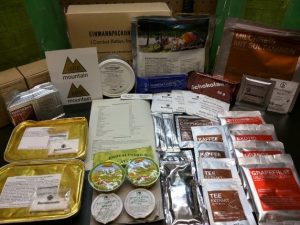

Can we address electrolyte imbalance from sweating and pushing water, especially in get-home and bug-out bags?
Do we have some of those “luxury” items? Not just feel-goods and energy-boost sweets, but also the tea, coffee, and variety that were important in rations back in the days bracketing the Great Depression, and were important enough for inclusion not only when gear was twice as heavy in the Civil War but also when families and military units had to tightly budget their load weights to cross half or two-thirds the continent?
How much leads to blood-sugar and energy swings (highs and crashes)?
Back to the earliest point, do we have a midday meal, or something akin to the many 24-hour rations where there may only be two “mains” but there are also snacky bits to munch through the day?
Happily, they’re pretty easy and inexpensive aspects to mitigate.
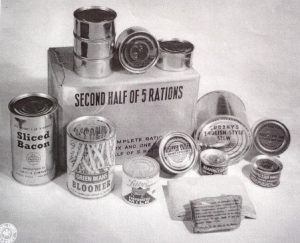


Expanding Our Rations
Bags of boiled sweets and chewy candy fruit jellies, nut-brittle bars, dehydrated fruits that offer natural sugar kicks, pre-seasoned cans of beans with sauces and flavors instead of only plain, granola bars, simple powdered milk (especially in flavors), and sports drink mixes – they’re all affordable options, homemade or purchased.
They’re more expensive and have short-ish shelf lives, but other options are higher-protein diabetic drinks, meal replacement shakes, and nuts and seeds.
Another is stocking or learning to cold-smoke and air-dry jerky and meat sticks, and stocking or creating any kind of crackers-spread combo.

Even old-fashioned oats or rolled barley will soak up water in a bag or jar while we work, and make for a compact-carrying but fairly easy and fast-eating munchies. So will instant grits or couscous, cream of wheat, and most quickie pasta meals.
Rice, dehydrated corn, and wheat groats take longer, but with some pinches of powdered broth, a chunk of pocket soup, or a dollop of salsa, they also offer a meal just for time spent soaking in the sun.
Any broth base and some rice or noodles, and we’re well on the way to fast, simple sun-brewed or quickie-fire soups – a belly-filling, warming comfort food eaten by soldiers further back than the Revolution, and still included in military rations today.


If sun-steeping is an option or a stove/oven is already running, hardtack soaked in broth or tea is also a long-storied calorie food.
Dehydrated grated or sliced potatoes and any of half a dozen seasoning packets from cheese soup to gravy will turn into a meal with 10-30 minutes of pre-soak and 10 minutes in a pan, or can be made with the portable solar options. Instant mashed potatoes are even faster.
We have endless possibilities for applying the trail-food lessons of the pioneers and old-time soldiers.
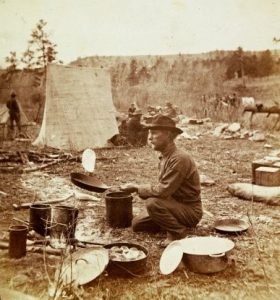
Variety & Luxuries in Tough Times
Like the early settlers and military packs, many of us have limited space and weight in our primary storage and in our bags. Like many of those settlers, most preppers are further limited by financial constraints.
Maybe that’s what makes it easy to scoff off some of the “add variety” suggestions.
Or, maybe we don’t look at fort-bound soldiers’ supplies and the Civil War ration goals. Maybe we overlook what we consider luxuries but almost all of them considered must-have staples.
Maybe we forget that worldwide, the men who spearheaded the expansion of military rations were also veterans of pretty lean, hungry times.


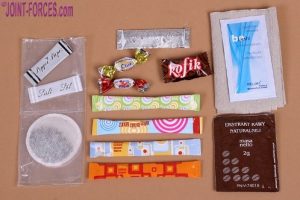
Maybe it’s easier to check blocks, ignore the working-man origins of tea time, and move on to something sexy like rifles (so many of which do not have slings, my head might really explode – ain’t gotta be fancy).
Maybe it’s easier, but history demonstrates the challenges that arise. It also gives us numerous solutions.
A few inexpensive, easy additions and a good cookbook can be used to create variety in even simple food supplies. The histories of the Mormon Trek and western expansion provide examples. For-real cattle-drive and Depression-era farmhouse recipes are another source.
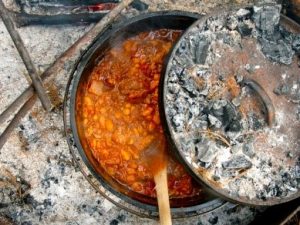


We can also research the lunch-dinner breaks of pioneers, old-time (and modern, poverty-stricken) farmhands, and soldiers of manly-man eras for pacing of meals and foods that give us continual boosts through the day, that can be consumed easily regardless of weather, and options that don’t require extra preparation or heating.
We do, absolutely, want to be sure we’re hitting the life-sustaining basics. We also, absolutely, want to make sure we get the most bang for our buck.
We don’t have to exactly replicate military rations, hit all of those luxuries, or hit them daily. However, it’s worth some attention, whether we’re preparing for a hurricane/snow storm or long-term, grid-down Armageddon.
Follow The Prepper Journal on Facebook!
The post Lessons from History – Variety & Luxury Foods appeared first on The Prepper Journal.
from The Prepper Journal
Don't forget to visit the store and pick up some gear at The COR Outfitters. How prepared are you for emergencies?
#SurvivalFirestarter #SurvivalBugOutBackpack #PrepperSurvivalPack #SHTFGear #SHTFBag

No comments:
Post a Comment